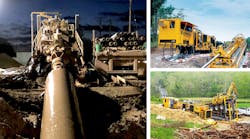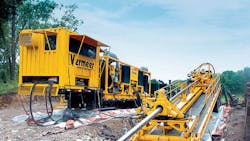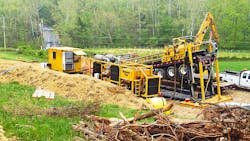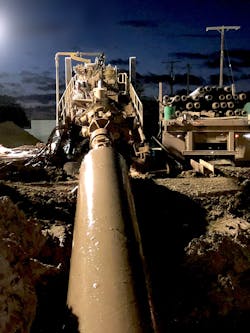Fasken Oil and Gas was building a 4.5-mile-long pipeline in Midland, Texas, that would carry oil, gas and water. It would also cross under two highways. That meant using horizontal directional drilling (HDD) to run more than 8,000 feet of 30 in. steel pipe underground. It was a long run, but the weight of the pipe they would pull back through the drilled hole was a bigger concern than the distance.
“We knew we could go the distance, and we knew we would have a good hole to work with, since it was solid rock, but we needed to make sure we had a rig that could pull all that weight back,” says the company’s general manager, Cory Baker. The firm calculated it would need a horizontal directional drill rig that could pull back up to 800,000 lb.
So, the Fasken team called Hard Rock Directional Drilling, a specialist in underground directional drilling.
Hard Rock determined it could do the job with two major machines, the D1000x900 HDD and D500x500 HDD Navigators from the Vermeer Corp.
The D1000x900 is powered by twin Caterpillar C-27 engines that crank out up to 92,000 ft-lb of rotational torque and 1,000,000 lb of thrust/pullback. The D500x500 delivers up to 52,900 lb of spindle torque and 493,000 lb of thrust/pullback.
Both machines are equipped with individual Hägglunds Gearless LS/HT (low speed/high torque) direct-drive hydraulic motors that power their rotary and carriage drives, providing full torque over a broad rpm range. The motors use a hydraulically balanced, radial-piston, cam-curve configuration. These Bosch Rexroth axial-piston motors have a multi-lobed cam with rollers on each of several axial pistons rather than a crankshaft as in conventional axial-piston designs. They offer the highest overall efficiency (up to 96%), and are the most reliable, with long life and less down time, according to the manufacturer. The motors do not need a gearbox, so they are compact, which helps give them a high power-to-weight ratio. They also withstand high shock loads.
The motors use a rotating cylinder block/hollow shaft and a stationary housing. The cylinder block mounts on fixed roller bearings in the housing. An even number of pistons circle the cylinder block, and the valve plate directs incoming and outgoing oil to and from the pistons. Each piston works against a cam roller. When hydraulic pressure acts on the pistons, the cam rollers get pushed against the slope on a cam ring rigidly connected to the housing, which generates torque. The cam rollers transfer the reaction force to the pistons, which are guided in the cylinder block. This creates rotation and creates torque proportional to the system’s pressure.While one Hägglunds motor drives the rotary function, the carriage thrust system incorporates a second motor and planetary drive. Both HDD machines have the same basic drive configurations, but numbers of motors are used to get the machine’s rated capacity. Individual variable-displacement pumps power and control the rotary and carriage motors hydrostatically, rather than using a single large pump to supply enough fluid to run both motors. Independent hydraulic circuits also retain any contamination from the affected circuit and its components.
At the site, the larger HDD machine was set up on one side of the bore, and the smaller drill was erected on the opposite side. Both carried 8 in. mud motors and 12.75 in. bits to make the pilot bore through the sandstone and limestone rock under the highway.
Next, the crews used both machines to make three successive larger passes, with 24 in., 36 in. and 48 in. hole openers, before connecting the 1.7 million lb pipe string to the D1000x900 for the pullback. It took 23 hours to pull the 30 in. pipe into position, using a maximum pull force of just under 600,000 lb—well below the machine’s 1,000,000 lb. capacity.
The initial bore was completed in 12 days, at an average depth of 60 ft.




